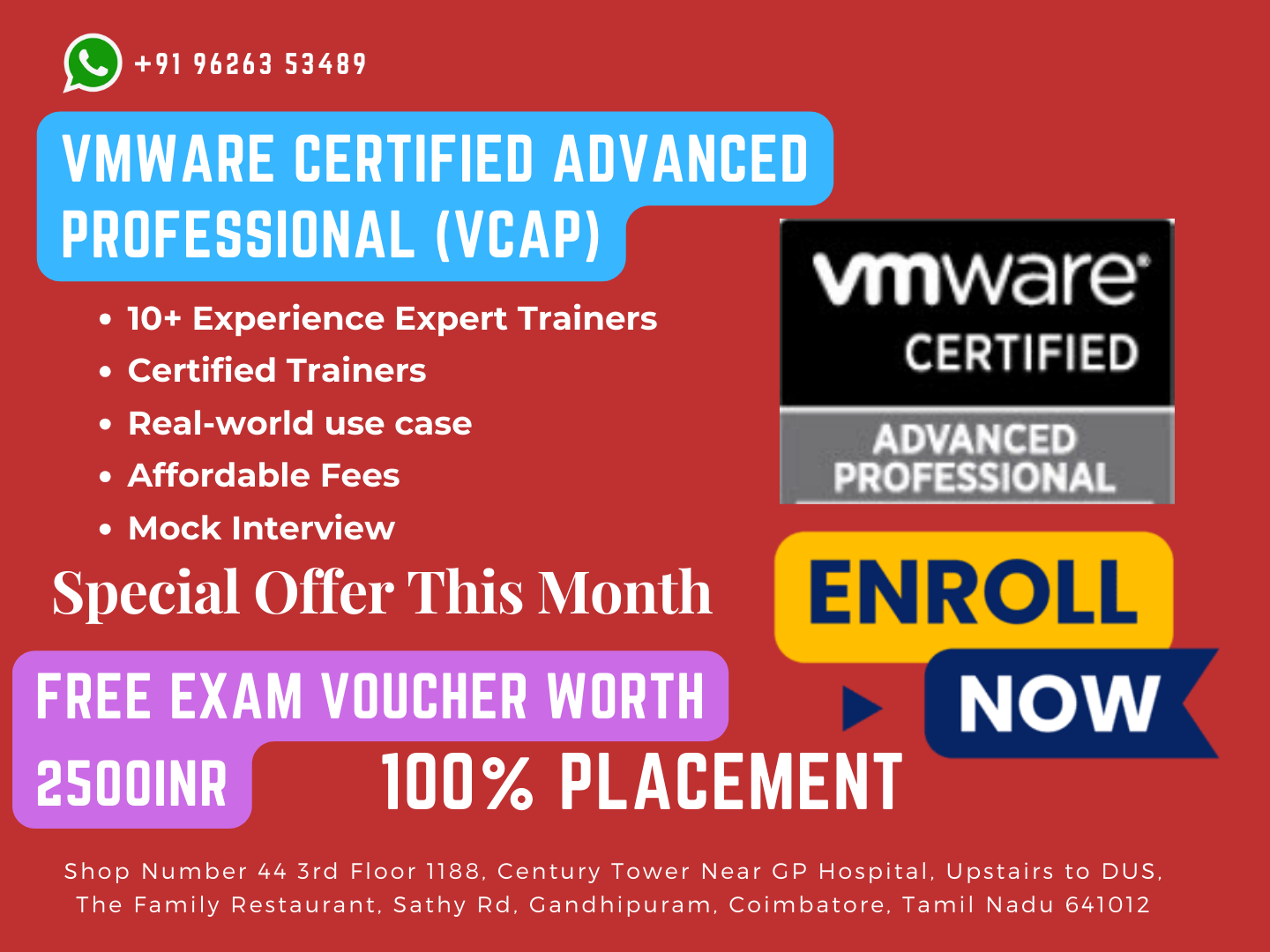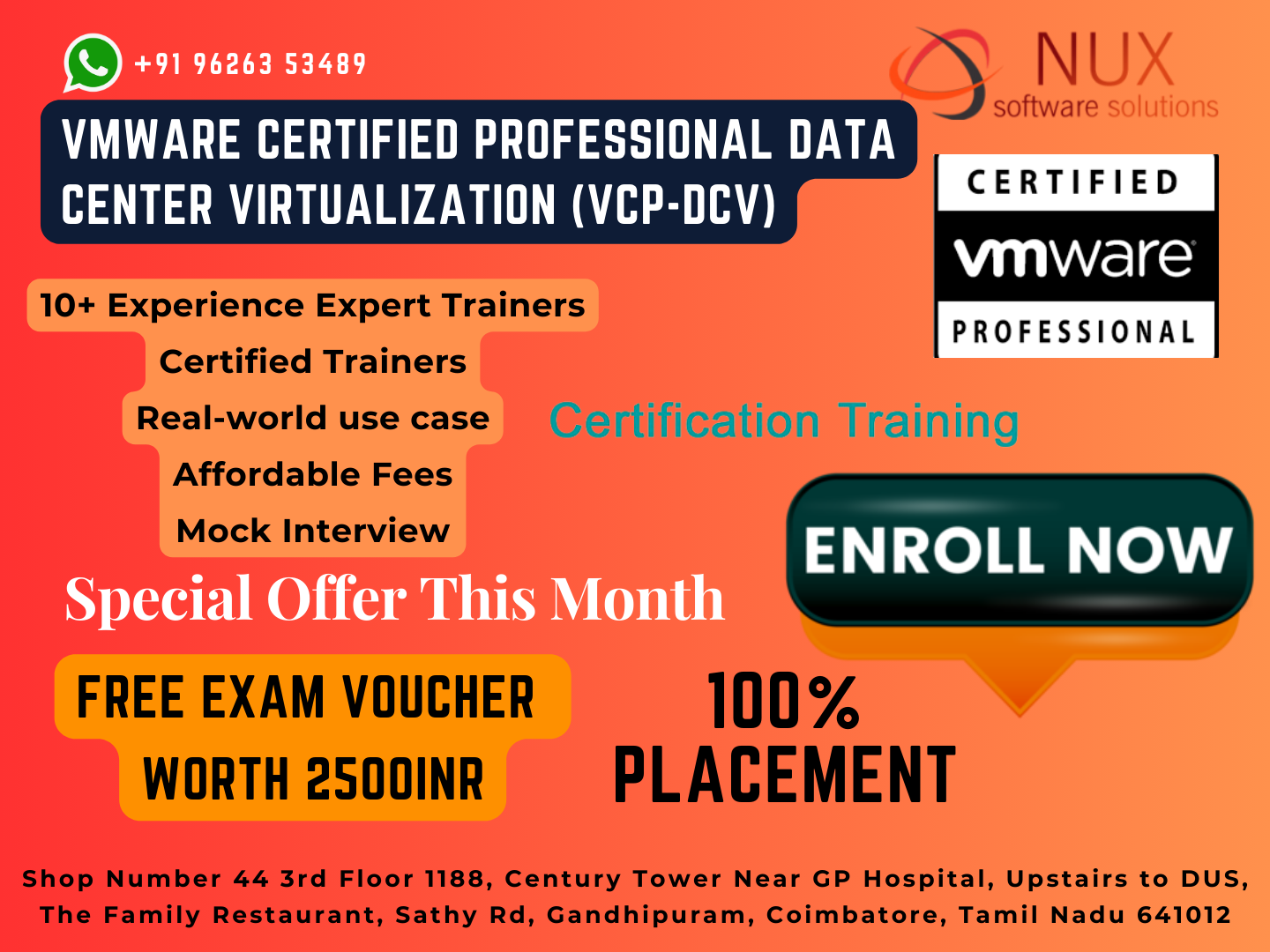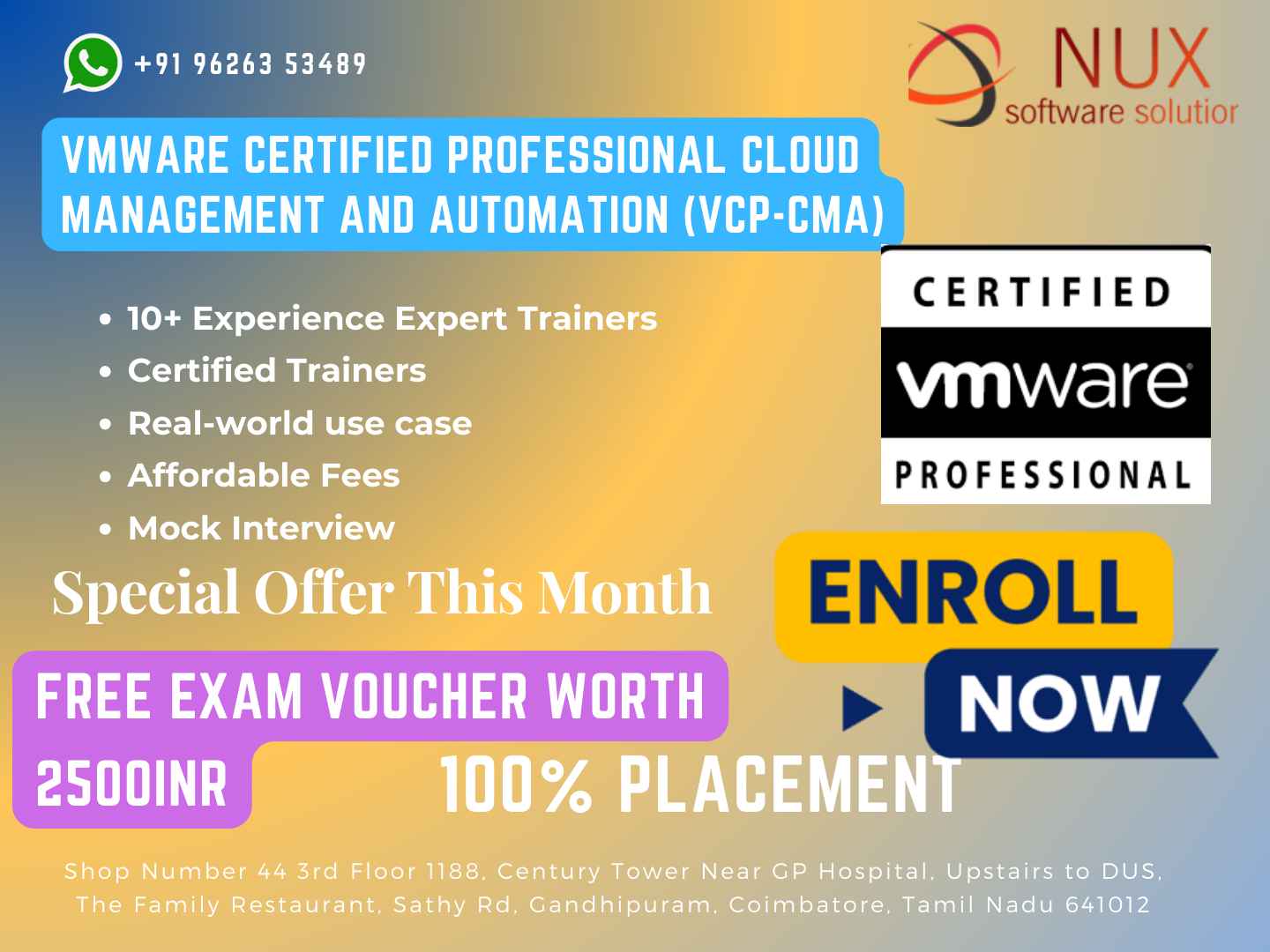Best VMware certified Associate Data Center Virtualization(VCA6-DCV)


It’s evident that Nux software Training & Certification Solutions is a powerhouse when it comes to VMware Certified Associate – Data Center Virtualization (VCA6-DCV) training in Coimbatore. The institute’s commitment to providing excellent and advanced training programs, along with a focus on hands-on experience, sets a solid foundation for learners.
The versatility of the training center, catering to professionals, individuals, corporate clients, and even live project and industrial training, reflects its adaptability to various learning needs. The 24X7 lab accessibility is a notable advantage, allowing learners to practice and refine their skills at their convenience.
The presence of international expert trainers with real-time industry experience adds significant value to the learning process. Their wealth of knowledge contributes to a comprehensive understanding of data center virtualization and aligns with industry best practices.
If there are specific aspects of VCA6-DCV certification, data center virtualization, or any other IT-related topics you’d like to delve into further, or if you have any questions or thoughts you’d like to discuss, feel free to let me know. I’m here to assist
Course Syllabus
Section 1: Explain Data Center Virtualization Concepts and Identify Typical Data Center Challenges
Identify and Explain the Concept of Data Center Virtualization
knowledge
- Explain Data Center Virtualization.
- Differentiate Physical and Virtual Data Center Components.
- Identify Data Center Virtualization Benefits.
Tools:
- Virtualization Basics
- VMware vSphere 6.0 Overview
- The Business Value of Virtualization
- Business and Financial Benefits of Virtualization
Identify Challenges that can be resolved with VMware vSphere with Operations Management
knowledge:
- Identify VMware vSphere Editions.
- Identify common management challenges.
- Identify common scalability challenges.
- Identify common optimization challenges.
Tools:
- Compare vSphere Editions
- VMware vSphere Essentials Kit and Essentials Plus Kit Datasheet
- The Business Value of Virtualization
- Business and Financial Benefits of Virtualization
Section 2: Identify, Explain and Differentiate VMware vSphere Technologies
Describe how the components of VMware vSphere support Data Center Virtualization
knowledge:
- Explain the concept and capabilities of virtual machines and vApps.
- Explain the concept and capabilities of a virtual machine.
- Identify purpose of ESXi and vCenter Server.
- Differentiate VMware migration technologies.
- Differentiate VMware availability technologies.
- Explain the concepts of clusters and resource pools.
- Identify and explain common VMware data center products.
Tools:
- Virtualization Basics
- VMware vSphere 6.0 Datasheet
- Explore vSphere Availability Features
- Explore vSphere Migration Features
- Explore Resource Management Features
- vSphere Web Client
Differentiate VMware vSphere Storage Technologies
knowledge:
- Differentiate physical and virtual storage.
- Explain the use of shared storage in a vSphere implementation.
- Differentiate VMFS and NFS datastores.
- Differentiate virtual disk provisioning methods.
- Explain Virtual SAN capabilities.
- Explain Virtual Volume capabilities.
- Identify capabilities of Storage I/O Control.
- Identify capabilities of Storage DRS.
- Explain VMware virtual storage technologies.
Tools:
- What’s New in in the VMware vSphere 6.0 Platform
- Explore vSphere Storage Features
- What’s New: VMware Virtual SAN 6.0
- What’s New: VMware vSphere Virtual Volumes
- Explore Storage I/O Control (SIOC) Features
- vSphere Web Client
Differentiate VMware vSphere Networking Technologies
Knowledge:
- Differentiate physical and virtual networking.
- Differentiate VMware virtual switch technologies.
- Identify VMware virtual switch components.
- Identify common virtual switch policies.
- Identify capabilities of Network I/O Control.
- Differentiate traffic control mechanisms.
Tools
- What’s New in in the VMware vSphere 6.0 Platform
- Explore vSphere Networking Features
- Network I/O Control (NIOC) Feature Summary
- vSphere Web Client
Differentiate VMware vSphere Resource Management Technologies
knowledge:
- Differentiate vSphere resource management features.
- Remediate resource management challenges.
- Identify all vMotion technologies (Storage, Resource, Long distance, etc.).
- Explain Distributed Resource Management, Distributed Power Management and High Availability.
Tools:
- What’s New in in the VMware vSphere 6.0 Platform
- Explore Resource Management Features
- Explore vSphere Migration Features
- vSphere Web Client
Differentiate VMware vSphere Availability Technologies
Knowledge:
- Differentiate vSphere high availability features.
- Remediate high availability challenges.
- Identify vSphere Disaster Recovery solutions.
- Differentiate VMware disaster recovery/disaster tolerance technologies.
- Explain vSphere Fault Tolerance.
- Identify vSphere Replication requirements.
Tools:
- Introduction to VMware vSphere Data Protection
- Introduction to vSphere Replication
- Explore vSphere Availability Features
- Introduction to Data Protection
- vSphere Web Client
Differentiate VMware Data Center Virtualization Products
Knowledge:
- Explain features of VMware NSX.
- Explain features of vRealize Operations.
- Explain features of vRealize Automation.
- Explain features of Site Recovery Manager.
Tools:
- What’s New in in the VMware vSphere 6.0 Platform
- VMware NSX Datasheet
- NSX Feature Walk Through
- vRealize Operations Datasheet
- vRealize Operations Feature Walk Through
- vRealize Automation Datasheet
- vRealize Automation Feature Walk Through
- VMware vRealize Air Homepage
- VMware vRealize Suite Datasheet
- vSphere Web Client
Section 3: Perform Operational Tasks using the vSphere Web Client
Identify and Understand Virtual Infrastructure Object Status
Knowledge:
- Identify different virtual infrastructure objects within the vSphere Web Client.
- Differentiate visual status indicators for various object states and conditions.
- Describe actions that can be taken on objects given a specific state of condition.
Tools:
- Using the vSphere Web Client
- vCenter Server and Host Management
- vSphere Virtual Machine Administration
- vSphere Web Client
Understand Hierarchy and Inventory Objects within the vSphere Web Client
Knowledge:
- Differentiate the functions of the vSphere Web Client panes.
- Describe vSphere Web Client Navigation, Filter and Search options.
- Describe the Access Control system.
- Understand how roles and/or permissions are assigned.
- Understand virtual machine file and inventory structure and mechanisms.
- Understand the benefit of tags assigned to inventory objects.
Tools:
- Using the vSphere Web Client
- vCenter Server and Host Management
- vSphere Virtual Machine Administration
- vSphere Permissions and User Management Tasks
- vSphere Web Client
Monitor Virtual Machine and ESXi Host Status
Knowledge:
- Install the Client Integration Plug-in.
- Install the VMware Remote Console.
- Install and/or Upgrade VMware Tools.
- Understand and differentiate virtual machine performance charts.
- Monitor Virtual Machine CPU/Memory/Disk utilization.
- Monitor ESXi Host health status.
- Monitor ESXi Host and virtual machine tasks.
- Monitor ESXi Host and virtual machine events.
- Monitor ESXi Host and virtual machine alarms.
Tools:
- Using the vSphere Web Client
- vCenter Server and Host Management
- vSphere Virtual Machine Administration
- vSphere Monitoring and Performance
- vSphere Web Client
Perform Virtual Machine Operations
Knowledge:
- Differentiate the power states of a virtual machine.
- Configure startup options for virtual machines running on a host.
- Manage the power operations of a virtual machine.
- Manage the power operations of a vApp.
- Install a guest OS to an existing virtual machine.
- Manage removable media.
Tools:
- Using the vSphere Web Client
- vCenter Server and Host Management
- vSphere Virtual Machine Administration
- vSphere Web Client
Section 4: Correlate VMware Virtualization Solutions with Common Data Center Business Challenges
Perform Virtual Machine Operations
Knowledge:
- Apply VMware virtualization technologies to resolve common data center availability challenges.
- Apply VMware virtualization technologies to resolve common data center management challenges.
- Apply VMware virtualization technologies to resolve common data center optimization challenges.
- Apply VMware virtualization technologies to resolve common data center scalability challenges.
- Differentiate SMB and Enterprise data center challenges and solutions that can be met with vSphere.
Tools:
- eBook: Delivering IT Outcomes
- VMware Solutions for Small and Mid-Sized Businesses
- Server Consolidation
- Software-Defined Data Center
- Business Continuity and Disaster Recovery


